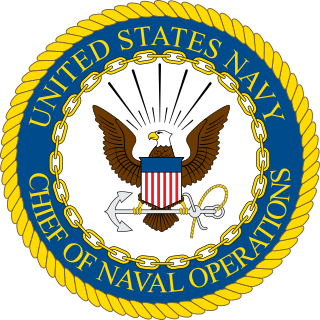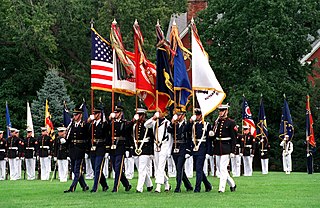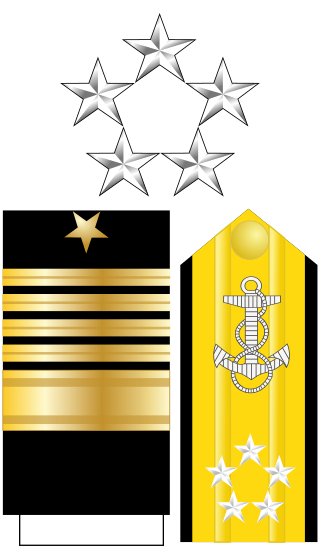
The chief of naval operations (CNO) is the professional head of the United States Navy. The position is a statutory office held by an admiral who is a military adviser and deputy to the secretary of the Navy. In a separate capacity as a member of the Joint Chiefs of Staff, the CNO is a military adviser to the National Security Council, the Homeland Security Council, the secretary of defense, and the president. The current chief of naval operations is Admiral Michael M. Gilday.

The Joint Chiefs of Staff (JCS) is the body of the most senior uniformed leaders within the United States Department of Defense, that advises the president of the United States, the secretary of defense, the Homeland Security Council and the National Security Council on military matters. The composition of the Joint Chiefs of Staff is defined by statute and consists of a chairman (CJCS), a vice chairman (VJCS), the chiefs of the Army, Marine Corps, Navy, Air Force, Space Force, and the chief of the National Guard Bureau. Each of the individual service chiefs, outside their JCS obligations, works directly under the secretaries of their respective military departments, e.g. the secretary of the Army, the secretary of the Navy, and the secretary of the Air Force.

The chairman of the Joint Chiefs of Staff (CJCS) is the presiding officer of the United States Joint Chiefs of Staff (JCS). The chairman is the highest-ranking and most senior military officer in the United States Armed Forces and the principal military advisor to the president, the National Security Council, the Homeland Security Council, and the secretary of defense. While the chairman of the Joint Chiefs of Staff outranks all other commissioned officers, the chairman is prohibited by law from having operational command authority over the armed forces; however, the chairman assists the president and the secretary of defense in exercising their command functions.

The First Sea Lord and Chief of the Naval Staff (1SL/CNS) is the military head of the Royal Navy and Naval Service of the United Kingdom. The First Sea Lord is usually the highest ranking and most senior admiral to serve in the British Armed Forces unless either the Chief or Vice-Chief of the Defence Staff are naval officers. Admiral Ben Key was appointed First Sea Lord in November 2021.

The several branches of the United States Armed Forces are represented by flags. Within the U.S. military, various flags fly on various occasions, and on various ships, bases, camps, and military academies.

Ernest Joseph King was an American naval officer who served as Commander in Chief, United States Fleet (COMINCH) and Chief of Naval Operations (CNO) during World War II. As COMINCH-CNO, he directed the United States Navy's operations, planning, and administration and was a member of the Joint Chiefs of Staff. He was the United States Navy's second most senior officer in World War II after Fleet Admiral William D. Leahy, who served as Chief of Staff to the Commander in Chief.

Osami Nagano was a Marshal Admiral of the Imperial Japanese Navy and one of the leaders of Japan's military during most of the Second World War. In April 1941, he became Chief of the Imperial Japanese Navy General Staff. In this capacity, he served as the navy's commander-in-chief in the Asia-Pacific theater until his removal in February 1944. After the war, he was arrested by the International Military Tribunal for the Far East but died of natural causes in prison during the trial.

Frank Friday Fletcher was a United States Navy admiral who served in the late 19th and early 20th centuries. He was awarded the U.S. military's highest decoration, the Medal of Honor, for his actions as commander of navy forces at the Battle of Veracruz, Mexico. The Fletcher-class destroyer, the most produced class of United States Navy destroyers, was named after him. He was also the uncle of Frank Jack Fletcher, another U.S. Navy Admiral who also received the Medal of Honor for actions at Veracruz, and who commanded U.S. naval forces at the battles of Coral Sea and Midway during the Second World War.

Fleet admiral is a five-star flag officer rank in the United States Navy whose rewards uniquely include active duty pay for life. Fleet admiral ranks immediately above admiral and is equivalent to General of the Army and General of the Air Force.

Joseph Mason "Bull" Reeves was an admiral in the United States Navy and an early and important supporter of U.S. Naval Aviation. Though a battleship officer during his early career, he became known as the "Father of Carrier Aviation" for his role in integrating aircraft carriers into the fleet as a major part of the Navy's attack capabilities.

Thomas Charles Hart was an admiral in the United States Navy, whose service extended from the Spanish–American War through World War II. Following his retirement from the navy, he served briefly as a United States Senator from Connecticut.
United States military seniority is the method by which the United States Armed Forces determines precedence among commissioned officers, in particular those who hold the same rank. Seniority is used to determine assignments, tactical commands, promotions and general courtesy. To a lesser extent, historical seniority is used to recognize status of honor given to early United States military leaders such as inaugural holders of certain ranks or those officers who served as leadership during major wars and armed conflicts.

The Mackerel-class submarines were a pair of experimental prototype submarines built just prior to World War II and launched in 1940 and 1941. The two submarines were similar in size and capability to the S-class submarines built at the end of World War I, and had been ordered to test the feasibility of using mass production techniques to build small submarines. Until at least 1940 it was thought that mass production of fleet submarines would be impractical, and in any case small submarines could provide area defense for submarine bases. Once it became apparent that there would be sufficient production of the more capable Gato-class submarines, interest in the design waned and no additional small submarines were ordered. Submarine production standardized during the war on the Gato class and its successors, the Balao and Tench-class submarines. In some references, the Mackerels are called the "M class".
The "bureau system" of the United States Navy was the Department of the Navy's material-support organization from 1842 through 1966. The bureau chiefs were largely autonomous, reporting directly to the Secretary of the Navy and managing their respective organizations without the influence of other bureaus. In 1966, the bureaus were gradually replaced by unified commands reporting to the Chief of Naval Operations.

Admiral Samuel Murray Robinson was a United States Navy four-star admiral who directed Navy procurement during World War II.

James Lemuel Holloway Jr. was a four-star admiral in the United States Navy who served as superintendent of the United States Naval Academy from 1947–1950; as Chief of Naval Personnel from 1953–1957; and as commander in chief of all United States naval forces in the eastern Atlantic and Mediterranean from 1957–1959, in which capacity he commanded the 1958 American intervention in Lebanon. As founder of the Holloway Plan, he was responsible for creating the modern Naval Reserve Officer Training Corps.

Rear Admiral Reginald Rowan Belknap was an officer in the United States Navy. He served in the Spanish–American War, Boxer Rebellion, Philippine–American War, and World War I. He gained distinction in 1909 for his relief work in Italy after the 1908 Messina earthquake and tsunami and for his work in command of the first offensive mining campaign in U.S. Navy history, the laying of the North Sea Mine Barrage in 1918. He was also a published author, an inventor, a member of many professional and social organizations, and an active member of the Episcopal Church, and he played a role in the selection of Amelia Earhart as the first female pilot to make a solo flight across the Atlantic Ocean.














